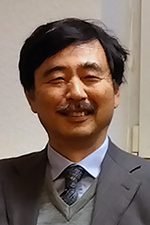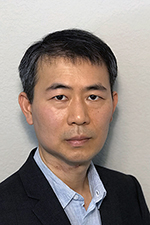New Members
ADCOM Class of 2027 Elected Members
Masaharu Nomachi

Masaharu Nomachi is a physicist in Osaka University. He received a Ph.D. in Physics from Osaka University, Japan in 1983, followed by postdoctoral work at Max Planck Institute for Nuclear Physics and the Department of Physics at Heidelberg University. He worked at CERN. In 1986 he joined the KEK online-data acquisition group. He leads development of the UNIX-based data acquisition system for SDC/SSC test experiments and experiments at KEK. In 1993, he joined the ATLAS/LHC experiment at CERN. In 1995, he moved to RCNP (Research Center for Nuclear Physics) at Osaka University. He leads the computer and network group at RCNP. In 1996, he organized an international workshop for network-based data acquisition systems in Osaka. From 2000, he worked in neutrino physics as a professor in the Graduate School of Science, Osaka University. He retired in March 2021. Since retiring, he has worked as a regional director of Osaka University European Center. It covers Europe, Russia, Middle East, and Africa. The aim of the European Center is promotion of international activities, which is an important roles of IEEE.
He is a senior member of the IEEE. He is a member of the NPSS CANPS committee. In 2014, he organized the 19th Real-Time Conference in Japan. He has organized international schools on radiation measurements. The school has been held seven times in 10 years, inviting students from Asian countries. Mini schools have also been organized several times in Asian countries. Collaborating with IEEE NPSS, the real-time school has been organized in Japan, Vietnam, and Malaysia. In two years (2022-2023). He was elected (2022-2023 to fill a partial AdCom term representing CANPS, and has been re-elected to serve a full four-year term.
Masaharu Nomachi can be reached by E-mail at [email protected].
Marty Shaneyfelt, Radiation Effects

Marty R. Shaneyfelt received his B.S.E.E. from the University of Nebraska, Lincoln, in 1984, and his M.S.E.E. from the University of New Mexico in 1990. From 1984 to 1990 he worked on technology development and manufacturing of radiation-hardened integrated circuits for Allied-Signal Microelectronics Operation, Albuquerque, NM. From 1990 until retirement in 2022, he worked at Sandia National Laboratories where he was a Distinguished Member of the Technical Staff. At Sandia, he was involved in numerous research activities associated with developing radiation-hardened bulk and SOI CMOS technologies, characterizing the physical mechanisms responsible for the radiation response of ICs, and developing hardness assurance approaches. Marty has authored or co-authored more than 220 publications, with many of these appearing in the IEEE Transactions on Nuclear Science. He has received thirteen IEEE Nuclear and Space Radiation Effects Conference (NSREC) Outstanding Papers Awards and four Hardened Electronics and Radiation Technologies Conferences Outstanding Paper Awards. Marty has considerable experience in service to the radiation effects community. As part of NSREC, he has served as General Chair, Finance Chair, Awards Committee, Local Arrangements Chair, Publicity Chair, Poster Session Chair, and Session Chair. He is presently serving on the Radiation Effects Steering Group (RESG) as the Vice-Chair of Finance and RESG Delegate to RADECS. Marty has also served as the RESG Executive Past-Chair, Executive Chair, Executive Vice-Chair, Member-at-Large, and Vice-Chair for Publications. Marty was elected a Fellow of the IEEE in 2002.
Marty Shaneyfelt can be reached by E-mail at [email protected].
Joseph Schumer, Plasma Science and Applications

Dr. Joseph W. Schumer (M’97, SM’12) is the Branch Head and a senior research physicist in the Pulsed Power Physics Branch, Plasma Physics Division of the U.S. Naval Research Laboratory (NRL) in Washington, DC, primarily involved in the research of plasma physics and nuclear science. He received degrees in Nuclear Engineering from the Missouri University of Science and Technology (B.S. 1992) and University of Michigan (M.S. 1994 and Ph.D. 1997). Since joining NRL in 1997, he has earned an international reputation as being an expert computational physicist by modeling plasmas, electron and ion powerflow, vacuum and plasma-filled diodes, plasma-wave interactions in microwave structures, and charged particle beams using magnetohydrodynamic, kinetic (Vlasov-Maxwell and particle-in-cell), and Monte-Carlo methods. He currently leads experimental and theoretical efforts related to pulsed power defense applications including the development of high-power nuclear weapons effects simulators and radiation sources; the design of pulsed power systems and charged particle beam diodes; validating advanced plasma chemistry/beam transport models using small- and large-scale laboratory experiments; development of compact pulsed power to drive high-powered microwave sources. In addition to above mentioned service to IEEE, Dr. Schumer serves as NRL Executive for DOE NNSA Office of Experimental Science, panelist on senior DOE Advisory Boards for radiation effects and high energy density sciences, and on various university Nuclear Engineering Advisory Boards since 2009. He holds a 4th degree black belt in Shotokan-Fudokan Karate, is an officer of the U.S. Fudokan National Organization, and enjoys hikes in northern Virginia with his wife Amy and two sons, Nate and Sam.
Joseph Schumer can be reached by E-mail at [email protected].
Mark Tillack, Fusion Technology

Dr. Mark Tillack is a Research Scientist Emeritus at the University of California San Diego. He received his Ph.D. in Nuclear Engineering from MIT in 1983, with a specialization in Applied Plasma Physics and Fusion Engineering. He was employed for 33 years at UCLA and UC San Diego as a Research Scientist studying fusion nuclear technology, fusion reactor design, and high-temperature plasma applications such as laser-produced plasma light sources for EUV lithography. Following retirement in 2016, he has remained active as a consultant to several national laboratories and private companies engaged in fusion technology development toward a practical energy source.
Dr. Tillack is a fellow of IEEE and has served as chair of the IEEE/NPSS Fusion Technology Standing Committee, General Chair of the 2009 IEEE/NPSS Symposium on Fusion Engineering and Technical Program Chair of SOFE in 1997 and 2015.
Mark Tillack can be reached by E-mail at [email protected].
Also elected, Mark Sinclair, Pulsed Power Science and Technology, AdCom Class of 2027. Mark Sinclair can be reached by E-mail at [email protected].
New Technical Committee Chairs
Youngho Seo, Nuclear Medical and Imaging Sciences

Youngho Seo is a Professor in the Department of Radiology and Biomedical Imaging at University of California, San Francisco (UCSF), Professor in the Department of Nuclear Engineering at the University of California, Berkeley, and Faculty Scientist at Lawrence Berkeley National Laboratory. He received his B.S. in Physics from KAIST where he investigated radiation effects on electronics by cosmic ray as his senior thesis research project. He completed an M.S. degree in Physics at the University of Alabama in Huntsville, focusing on space plasma physics. He spent one year at the University of California, Irvine as a medical physics student before moving to UCLA where he obtained his second master’s degree and Ph.D. in Physics with his dissertation on a dark matter experiment using dual-phase xenon under the supervision of Professor David Cline. He spent another year for postdoctoral training at the same institution in experimental neutrino physics as a member of the ICARUS collaboration.
Dr. Seo joined the UCSF Physics Research Laboratory (PRL) in 2003 and was trained in medical imaging physics under the supervision of Professor Bruce Hasegawa before joining the faculty in 2006. His primary research focus is to use quantitative SPECT/CT, PET/CT, and PET/MR molecular imaging tools for a broad range of research areas from small animal imaging using dedicated animal imaging systems and basic instrumentation development for physics analysis of clinical research data. Dr. Seo has been a senior member of IEEE since 2011, and often a member of the organizing committees of IEEE NSS/MIC/RTSD with the roles of short course chair and publication chair. He joined NMISC in 2020 as a member, and has led or participated in committee activities focusing on Initiatives and Publications.
Youngho Seo can be reached by e-mail at [email protected].
Emily Schrock is the new chair of the Pulsed Power Science and Technology Committee. She can be reached by E-mail at [email protected].
New Functional Committee Chair
Angela Di Fulvio, Chapters

Dr. Angela Di Fulvio is an Associate Professor in the Nuclear Plasma and Radiological Engineering (NPRE) Department at UIUC and director of the Nuclear Measurement Laboratory. Before joining NPRE in 2018, Dr. Di Fulvio was a research scientist at the University of Michigan. Her group developed novel neutron multiplicity counters for the characterization of subcritical assemblies, radiation detection systems and algorithms for advanced nuclear reactors, gamma-ray and neutron imagers, spectrometry, and dosimetry systems, and tested such devices on special nuclear materials at national laboratories and in the field.
Dr. Di Fulvio and her research group design, simulate, develop, and characterize radiation detection systems, with a focus on neutron spectroscopy and imaging, and use Bayesian and deep learning algorithms to maximize the information retrieved from such systems.
Di Fulvio has been an IEEE NPSS member since 2014 and joined the IEEE-NPSS Radiation Instrumentation Steering Committee (RISC) in 2023.
Dr. Martin Nieto-Perez will join Angela as co-chair of the Chapters committee
Angela Di Fulvio can be reached by E-mail at [email protected].